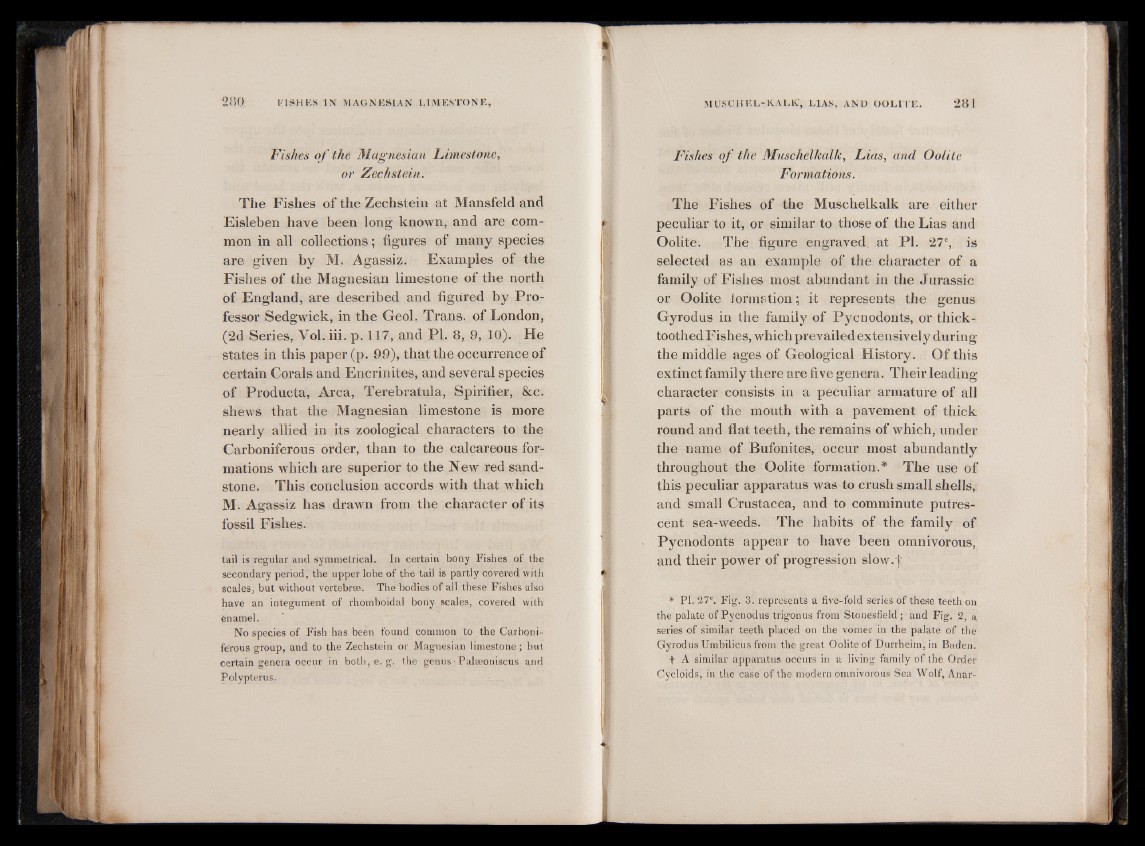
Fishes o f the Magnesian Limestone,
or Zechstein.
The Fishes of the Zechstein at Mansfeld and
Eisleben have been long known, and are common
in all collections; figures of many species
are given by M. Agassiz. Examples of the
Fishes of the Magnesian limestone of the north
of England, are described and figured by Professor
Sedgwick, in the Geol. Trans, of London,
(2d Series, Yol. iii. p. 117, and PI. 8, 9, 10). He
states in this paper (p. 99), that the occurrence of
certain Corals and Encrinites, and several species
of Producta, Area, Terebratula, Spirifier, &c.
shews that the Magnesian limestone is more
nearly allied in its zoological characters to the
Carboniferous order, than to the calcareous formations
which are superior to the New red sandstone.
This conclusion accords with that which
M. Agassiz has drawn from the character of its
fossil Fishes.
tail is regular and symmetrical. In certain bony Fishes of the
secondary period, the upper lobe of the tail is partly covered with
scales, but without vertebrae. The bodies of all these Fishes also
have an integument of rhomboidal bony scales, covered with
hnamel.
No species of Fish has been found common to the Carboniferous
group, and to the Zechstein or Magnesian limestone; but
certain genera occur in both, e. g, the genus • Palseoniscus and
Polypterus.
Fishes o f the Muschelkalk, Lias, and Oolite
Formations.
The Fishes of the Muschelkalk are either
peculiar to it, or similar to those of the Lias and
Oolite. The figure engraved at PI. 27c, is
selected as an example of the character of a
family of Fishes most abundant in the Jurassic
or Oolite lormation; it represents the genus
Gyrodus in the family of Pycnodonts, or thicktoothed
Fishes, which prevailed extensivel y during
the middle ages of Geological History. Of this
extinct family there are five genera. Their leading
character consists in a peculiar armature of all
parts of the mouth with a pavement of thick
round and flat teeth, the remains of which, under
the name of Bufonites, occur most abundantly
throughout the Oolite formation.* The use of
this peculiar apparatus was to crush small shells,
and small Crustacea, and to comminute putrescent
sea-weeds. The habits of the family of
Pycnodonts appear to have been omnivorous,
and their power of progression slow, j
* PI. 27c. Fig. 3. represents a five-fold series of these teeth on
the palate of Pycnodus trigonus from Stonesfield ; and Fig. 2, a
series of similar teeth placed on the vomer in the palate of the
Gyrodus Umbilicus from the great Oolite of Durrheim, in Baden.
f A similar apparatus occurs in a living family of the Order
Cycloids, in the case of the modern omnivorous Sea Wolf, Anar